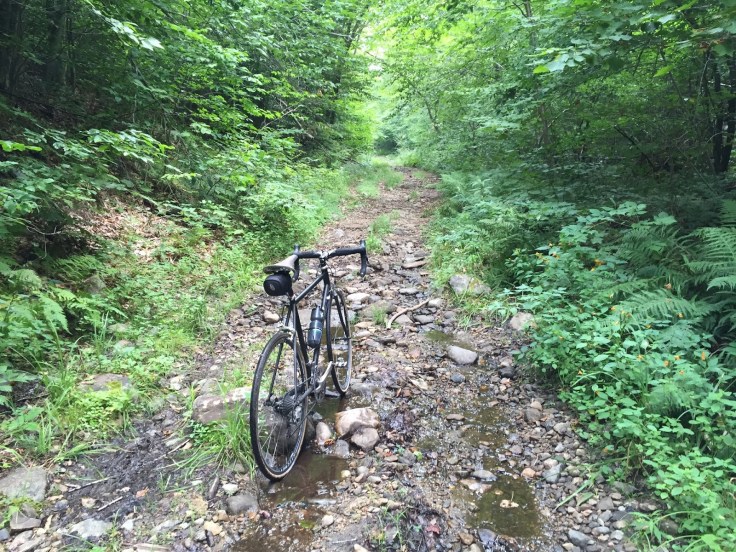It’s that time of year when I start auditioning bikes for summer vacation.
So which bike will get to come with me?
Yesterday I auditioned this one:

In fact it’s the very bike I took with me on our first summer vacation almost a decade ago–though it was a different color back then, and I didn’t know where I was going, so I got in a little over my head when I went looking for “gravel:”

Of all my bikes, the Milwaukee is the one that’s been in continuous service the longest. Yes, there are bikes I’ve had for longer, such as the Faggin:

Though until I put it back together again recently the frame had been sitting in storage for like 10 years, so it doesn’t count.
And yes, I’ve now got new cartridge bearings to fix that rattly front Spinergy, so we’ll soon see if I’m able to install them without causing the wheel to ass-plode…though I guess that’s better than the wheel ass-ploding while I’m riding it.
I tinker with the relics of cycling history so you don’t have to.
One make of bicycle that is no longer represented in my holdings is Specialized; I’ve owned several over the years, and my most recent one was the RockCombo:

Which like so many other former New Yorkers now lives in New Jersey:

Also like many former New Yorkers who now live in New Jersey, it seems much happier and healthier since it left.
I’ve been doing more road riding these days, and on the popular New York City-area routes it seems like at least half the Fred bikes on the road right now are Specializeds. (Is “Specializeds” the plural of Specialized, or do you just say Specialized?) Such is the ubiquity of The Big Red “S” that you hardly even notice the logo anymore–but I did notice one of these stuck to a pole this past weekend, and shortly afterwards I caught up to a group or riders with more of them adhered to to their helmets and torsos:

It appeared to be some sort of anti-Specialized campaign, and immediately I was torn. On one hand I was excited, because I’m always looking for an excuse to criticize Specialized, but on the other hand I was annoyed, because if I see young people protesting I automatically take the other side:

As a result, I had no other choice but to remain neutral and open-minded, and as I approached them I asked what the stickers were about. One of the riders informed me that Specialized had closed a factory in El Salvador without paying the workers, which surprised me because I had no idea Specialized was making Tarmacs in El Salvador. Then another rider offered me a sticker, which I accepted and placed in my jersey pocket. I’ve since scanned the QR code, and as it turns out, there was a factory in El Salvador making apparel for a number of companies:

And Specialized is one of two companies that supposedly still owes the workers compensation after the factory closed:

It sounded bad, but it also sounded a little pat, and once again I was torn:

So I read a little more about it:

And of course it’s a little more complicated than the sticker suggests:

No doubt the bike industry has a “sustainability blind spot:”

Or, more accurately, they engage in shameless “virtue signaling:”

Which is really just what marketing has become in the 21st century:

And of course marketing has never reflected reality in this or any other century.
Nevertheless, it sounds like Specialized did pay something, contrary to what the Green America site says:

The argument is whether or not it was enough:

But admittedly #SpecializedHiredASupplierToProduceOverpricedApparelAtAFacoryInElSalvadorWhichClosedAndAfterMuchNickelAndDimingOnSpecialized’sPartTheyPaidThe WorkersLikeFortyGrandButWeReallyThinkTheyReallyShouldHavePaidMore doesn’t make for a very convenient hashtag.
In any case, it’s not hard to believe Specialized are being shitty and don’t want to spend the money at a time when bike companies aren’t doing so good, but it’s also not hard to believe that their share of a garment factory’s output is in fact way, way smaller than that of the other companies that were using that factory, like Hanes, a company with something like $7 billion in annual revenue, or Gildan with $5 billion, versus Specialized’s $500 million (at least according to about nine seconds of research on a popular search engine).
But that doesn’t matter when you’re competing for the hearts and minds of the next generation of cyclists, and all it takes is one sticker for them to ditch Specialized and grab hold of the PNS:

[PNS model demonstrating the ol’ reacharound.]
And if you ever wondered about the intensity of a PNS’s emissions, here’s your answer:

The graph on the left really says it all:

As for how much your PNS is warming the planet, here’s your answer:

It may seem like a lot, but rest assured it’s merely .00000000001% of the warming caused by one (1) Kathy Hochul:

I know because I read it on Streetsblog.
And if that weren’t enough, all PNS stores will be powered by renewable energy in 2024:

I really hope that power is generated by a PNS model on a trainer:

[“We’ll do anything if you’ll finally feed us, we haven’t eaten in weeks.”]
It’s your move, Specialized.
